Rochester: Kent's Other Cathedral Town
by Richard Crowhurst
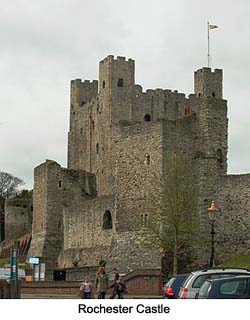 Rochester
is old. In Roman times it was called Durobrivae and the first
Bishopric was founded by St Augustine in 604 AD. The city is
mentioned by the Venerable Bede (731 AD) and Doomsday (1086 AD).
The city's own municipal records date back to 1227 and the city's
royal charter was granted in 1461. Traditionally the Mayor of
Rochester has also held the post of Admiral of the River Medway,
but the recent creation of Medway Council has led each town in
the Medway conurbation to lose a little of its own character. Rochester
is old. In Roman times it was called Durobrivae and the first
Bishopric was founded by St Augustine in 604 AD. The city is
mentioned by the Venerable Bede (731 AD) and Doomsday (1086 AD).
The city's own municipal records date back to 1227 and the city's
royal charter was granted in 1461. Traditionally the Mayor of
Rochester has also held the post of Admiral of the River Medway,
but the recent creation of Medway Council has led each town in
the Medway conurbation to lose a little of its own character.
Rochester, one of two Cathedral cities in Kent, has managed to
resist this process from its position in a loop on the southern
bank of the Medway. Today it trades heavily on its history:
military, literary and religious. With its Norman castle and
cathedral, long association with the novelist Charles Dickens, a
host of interesting shops and other historic features, the city
amply rewards those who take time to explore it. This is easily
achieved on foot, around the compact city centre.
The High Street
The Victorian High Street (which incorporates Eastgate Street) is
the spine of the city. It runs northwest from the bottom of Star
Hill to the distinctive bridge that crosses the river Medway to
neighbouring Strood. The new visitor to the city can do worse
than calling in at the modern Visitor Information Centre, about
halfway along the High Street. Details of many attractions can be
found here, along with a small coffee shop. The first floor
houses the Rochester Art Gallery, with a changing programme of
art and craft displays.
The High Street is also the best
destination for weary visitors looking for refreshment. Whether
you fancy a traditional English pub, chic bistro or afternoon
tea, a wide range of pubs, cafes and restaurants line both sides
of the main thoroughfare. Details of guided and self-guided
walking tours around the centre of the city are available from
the Visitor Centre.
The following description of the High Street assumes you are
walking northwest towards the bridge.
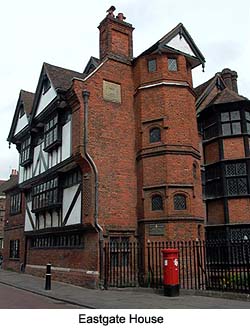 The first building of note is Eastgate House.
Until 2004, this was the Charles Dickens Centre and housed an
exhibition on the author and his life. The centre has now closed,
but a new and much larger attraction is planned to open in nearby
Chatham in 2006. The building was constructed between 1590 and
1591 by Sir Peter Buck, mayor of Rochester and Earl of
Northumberland. The building became a school in the 18th and 19th
centuries. For readers of Dickens' work, Eastgate House is
immortalised as Westgate House in The Pickwick Papers and
The Nun's House in The Mystery of Edwin Drood. In the
small garden at the rear of the building you can see Dickens'
Chalet, which was moved here from the garden at Gad's Hill Place,
the house he owned at Higham (some four miles west of
Rochester). The first building of note is Eastgate House.
Until 2004, this was the Charles Dickens Centre and housed an
exhibition on the author and his life. The centre has now closed,
but a new and much larger attraction is planned to open in nearby
Chatham in 2006. The building was constructed between 1590 and
1591 by Sir Peter Buck, mayor of Rochester and Earl of
Northumberland. The building became a school in the 18th and 19th
centuries. For readers of Dickens' work, Eastgate House is
immortalised as Westgate House in The Pickwick Papers and
The Nun's House in The Mystery of Edwin Drood. In the
small garden at the rear of the building you can see Dickens'
Chalet, which was moved here from the garden at Gad's Hill Place,
the house he owned at Higham (some four miles west of
Rochester).
Further along, the High Street opens out to reveal a modern car
park beside Blue Boar Lane. Of interest here are the remains of
the old city wall visible at the rear of the car park.
Dating in parts from the 2nd century AD, this is the only part of
the wall that retains its original height (thanks to 19th century
development). The line of the wall follows the original Roman
defences and some Roman masonry remains.
The next landmark of note, also on the right, is the French
Hospital La Providence. Today these imposing buildings
carry on the traditions of the first 'Hospital for French
Protestants and their Descendants Residing in Great Britain,'
which was established by the bequest of Jacques de Gascony in
1708. He was a Huguenot refugee and Master of the King's
Buckhounds. In 1960 the then Bishop of Rochester instigated the
purchase of Theobald's Square, which was converted into private
housing for elderly people of Huguenot descent.
A few doors further up, opposite the Visitor Information
Centre & Art Gallery, one of the classic views of the
Cathedral, with its imposing triangular tower, comes into view
behind the War Memorial Garden.
The Poor Travellers House was founded by Watt's Charity on
the instructions of Richard Watts at his death on the 10th
September 1579. The existing almshouse was upgraded with 'six
good matrices of Flock Bedds and other good and sufficient
furniture to harbour and lodge in poor Travellers.' Travellers
were allowed to stay for just one night, and were given fourpence
when they departed the next morning. This meagre amount was
finally increased to a shilling in 1934! The house continued to
provide temporary lodgings until the Second World War. It was
closed in July 1940. In 1979 the ground floor, garden and
traveller's bedrooms were converted to a museum. Exhibits and
literature tell the story of Richard Watts and his charity. The
house is generally open Tuesday-Saturday, between March and
October. Like many buildings in the city the house proved
inspirational for Charles Dickens, who wrote his short Christmas
story The Seven Poor Travellers after a visit in 1854.
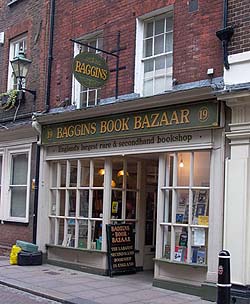 Further west, the
pedestrianized High Street forms a crossroads with Boley Hill and
North Gate, under the watchful gaze of the castle. Two famous
inns -- the King's Head hotel and Ye Arrow -- can be found here,
as well as the distinctive stone and timber gate structure known
as Jasper's Gate. More correctly called Chertseys Gate; it
dates from the early 15th century, when it was constructed to
guard the cathedral precincts. The timber house was added to the
top of the gate about 300 years later. Further west, the
pedestrianized High Street forms a crossroads with Boley Hill and
North Gate, under the watchful gaze of the castle. Two famous
inns -- the King's Head hotel and Ye Arrow -- can be found here,
as well as the distinctive stone and timber gate structure known
as Jasper's Gate. More correctly called Chertseys Gate; it
dates from the early 15th century, when it was constructed to
guard the cathedral precincts. The timber house was added to the
top of the gate about 300 years later.
Just up from the crossroads, Two Post Alley reflects how
Rochester must have looked in years gone by, with its mixture of
shop fronts and old architecture. A few doors further along on
the opposite side of the road is a place of pilgrimage for
bibliophiles around the world: Baggins Book Bazaar, the
largest second-hand bookshop in England. Anyone with the
slightest love of books or reading can't help but lose themselves
in the maze of rooms and shelves that occupy two very uneven
floors. From genuine collectibles to cheap paperback novels,
you're sure to find something of interest inside.
The last two buildings of note to tourists before the bridge are
the Guildhall, now a museum (see below), and the Royal
Victoria and Bull Hotel. Although the exterior suggests the
latter is now somewhat past its prime, this was a typical and
busy coaching inn in the 19th century. Princess (later Queen)
Victoria slept here in 1836, and it too has Dickensian links, the
most famous of which is arguably in The Pickwick
Papers.
The Esplanade
The junction between the High Street and The Esplanade has been
spoilt, for modern visitors, by the busy road junction, where the
main A2 road through the Medway towns crosses the river. The
green iron bridge on the southern side (carrying London-bound
traffic) was built in 1856 and modified in 1914. The bridge is
maintained by the Bridge Trust (known locally as the Bridge
Wardens), which has ensured endowments for the upkeep of a
crossing here since 1391. In 1970 they built the less impressive
bridge alongside the older structure.
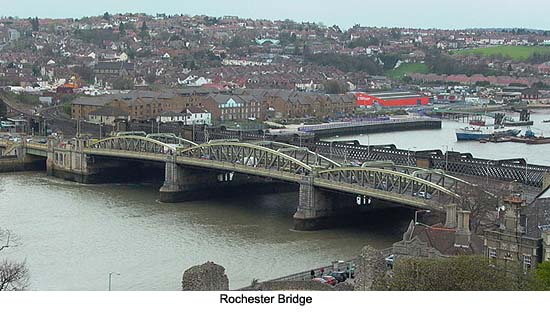
Just around the corner on the Esplanade is the Bridge
Chapel, the 14th-century home of Sir John Cobham. Cobham was
fundamental in the founding of the medieval bridge and the house
is fittingly used as the meeting place of the Rochester Bridge
Trust to this day.
Further along the wide road of The Esplanade, which runs
alongside the river below the outer wall of the castle, a pier
juts out into the muddy banks of the tidal river. In the summer
months it is possible to take a trip on the restored paddle
steamer Kingswear Castle. Details and timetables can be
found at http://www.pskc.freeserve.co.uk.
Rochester Castle
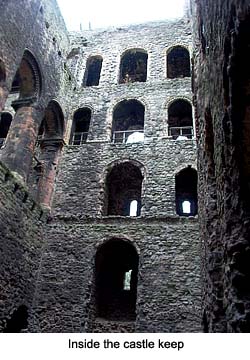 No
visitor to Rochester can fail to spot the imposing remains of its
Norman castle. Rochester was one of the first towns to be
fortified by the Normans after their invasion in 1066. The first
castle was largely constructed of earthworks and timber, built
using recycled parts of the city's Roman defences. In 1087,
William the Conqueror's best architect, Bishop Gundulf, began the
reconstruction of the castle entirely in stone. However, it
wasn't until some time after 1127 that Archbishop William de
Corbeil finished the masterpiece of the keep with its prestigious
accommodation. The resulting castle was one of the finest in
England, and even today the great keep remains one of the tallest
in the country at 113 feet high. In order to support the massive
weight of the building, the walls extend up to 12 feet in
thickness. No
visitor to Rochester can fail to spot the imposing remains of its
Norman castle. Rochester was one of the first towns to be
fortified by the Normans after their invasion in 1066. The first
castle was largely constructed of earthworks and timber, built
using recycled parts of the city's Roman defences. In 1087,
William the Conqueror's best architect, Bishop Gundulf, began the
reconstruction of the castle entirely in stone. However, it
wasn't until some time after 1127 that Archbishop William de
Corbeil finished the masterpiece of the keep with its prestigious
accommodation. The resulting castle was one of the finest in
England, and even today the great keep remains one of the tallest
in the country at 113 feet high. In order to support the massive
weight of the building, the walls extend up to 12 feet in
thickness.
Today the quiet, landscaped gardens within the outer wall fail to
evoke the castle's violent history. In 1215, King John, brother
to Richard the Lionheart, laid siege to the castle, taking it
after demolishing the southwest tower by undermining it. The
miners dug a tunnel under the wall and then used the fat of forty
pigs to burn the tunnel's timber supports and collapse both it
and the huge tower above it. The tower was rebuilt around 1226
with a cylindrical shape to strengthen it against the possibility
of missiles from siege engines.
Visitors can climb to the top of the walls, but be warned -- this
is not a trip for those afraid of heights. The castle is open to
the elements, and the flimsy pigeon netting strung across the top
doesn't even seem to be able to keep the birds out. An audio tour
is available to guide you around what's left of the keep, and,
after several sets of uneven steps, the battlements offer
spectacular views across the river and over the cathedral. An
exhibition in the former chapel shows the construction and
evolution of this great castle, and the lack of floors provide
visitors with a better understanding of castle construction than
many better-preserved defences. The Visitor Information Centre in
the High Street houses a free 'virtual tour' of the castle as it
would have been in its Norman heyday, and this provides an
interesting contrast with the atmospheric and brooding stones
that remain.
Rochester Cathedral
The main entrance to the Cathedral is located in Boley Hill,
opposite the watchful gaze of the castle walls. Another side
entrance by the Deanery Gate allows access to wheelchairs,
pushchairs and the like. This was the route used by pilgrims
visiting the shrine of St William of Perth, and today it brings
visitors close to the pilgrimage steps within the cathedral.
William was on a pilgrimage to Rome when he was killed. In time
his shrine, which dates from before the reformation, became a
place of pilgrimage in its own right.
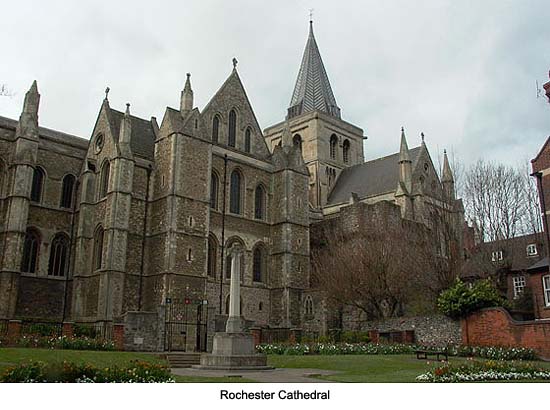
The impressive portico is guarded by a vast catalpa tree,
whose hundred-year-old branches are guarded by railings. Once
inside the impressive nave, you get a sense of the scale of this
great religious building. The Norman cathedral, constructed by
Bishop Gundulf between 1080 and 1100 AD, was built on the site of
the older, and by then decaying, Saxon cathedral. The decorative
carvings on the arcades and columns were added later by Bishop
Ernulf (1115-1124). Until 1423 the nave served as the parish
church of St Nicholas, when a new church dedicated to the saint
was built next door. Today the Diocese of Rochester stretches
from Penge in south London in the west to Rainham in the east.
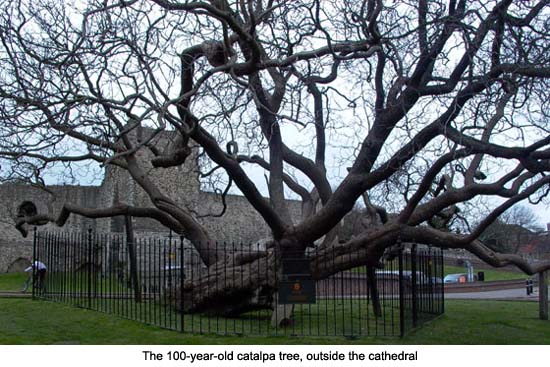
Entry to the Cathedral is free, although visitors are invited to
make a donation of £3 and photography permits are also
available. The Cathedral may be closed for certain religious
ceremonies and festivals, and it is as wise to check opening
times before travelling. Highlights of the building include the
Baptismal Fresco (dedicated in 2004 after eight years of
preparation), the Crypt, and the Presbytery with its vaulted
sedilia. The fresco is the first to be painted in an English
Cathedral in 800 years and features images of John the Baptist,
Saint Augustine and the Saxon Bishop Justus. The Sanctuary Lamp
comes from the Church of the Holy Sepulchre in Jerusalem and was
donated in 1920. It hangs over the impressive high Altar,
designed by Gilbert Scott in 1880. In early September, evening
visitors to the Cathedral and castle are treated to a son et
lumiere display, as both buildings are lit by a seasonal light
show.
The Guildhall Museum
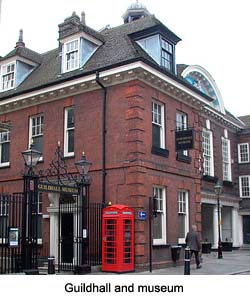 This free museum is one of
the jewels in Rochester's crown. The displays housed in the small
Guildhall and neighbouring Medway Conservancy Board Building
chart the history of the Medway area from the Neolithic to the
present day. A model of the castle keep shows the techniques used
by Prince John to undermine the southwest tower. Another exhibit
illustrates extracts from the diary of Samuel Pepys (who was a
Clerk to the Navy Board) at the time when the Dutch Fleet broke
the defensive chain across the river and threatened the naval
dockyards at Chatham and Upnor. This free museum is one of
the jewels in Rochester's crown. The displays housed in the small
Guildhall and neighbouring Medway Conservancy Board Building
chart the history of the Medway area from the Neolithic to the
present day. A model of the castle keep shows the techniques used
by Prince John to undermine the southwest tower. Another exhibit
illustrates extracts from the diary of Samuel Pepys (who was a
Clerk to the Navy Board) at the time when the Dutch Fleet broke
the defensive chain across the river and threatened the naval
dockyards at Chatham and Upnor.
It is impossible to separate the river from the towns lying along
its banks, and a variety of river vessels are represented, from
shallow-hulled sailing barges to Nelson's Trafalgar flagship, HMS
Victory (which was built in the dockyards at Chatham). There were
other vessels, however, with a darker side. The Hulks
Experience takes you back to the Napoleonic era when
prisoners-of-war and convicts were crammed into old warships
moored in the river estuary. Despite the appalling conditions,
many prisoners managed to create exquisite works or art and some
of this 'war work' is on display.
As well as temporary exhibits, there are permanent recreations of
domestic rooms, from a Victorian drawingroom to a 1900's kitchen
and scullery. You can also see a bird's-eye view of the high
street using the camera mounted to the weather vane on the roof
of the Conservancy Board building, and watch the video exhibition
on the history of Medway's music halls. All in all, no trip to
Rochester should be allowed to pass without spending an hour or
so in this free museum.
Other Attractions If you have time during your visit,
check out some of these other buildings and areas just beyond the
city centre.
Behind the Cathedral, in Minor Canon Row (originally built
to house members of the clergy) you can see the Cloister
Garth, where the monastery was originally attached to the
chancel of the Cathedral. The Prior's Gate dates from the
15th century and is the most complete of the monastic gates that
still surround the cathedral precincts. Further along the road,
after passing Oriel House and some of the buildings of
King's School, you come to The Vines. These quiet
gardens were originally the monastery's vineyards. The wooden
carving of a monk was formed from the stump of a plane tree
damaged by the hurricane force storms that swept Kent in 1987.
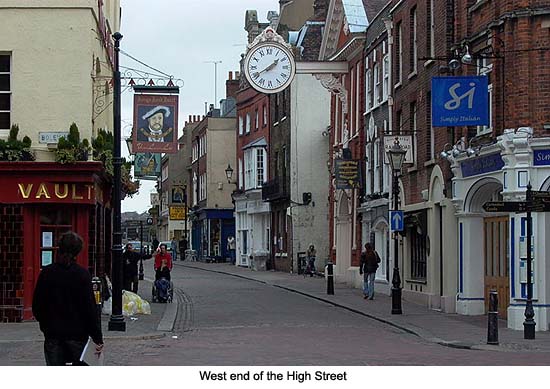
Overlooking The Vines, in Crow Lane, is Restoration House.
Although the house has entertained both Charles II and Samuel
Pepys, today it is best remembered as Dickens' model for Satis
House, home of the bitter and jilted Miss Havisham in Great
Expectations.
The real Satis House was the home of Richard Watts;
founder of The Poor Traveller's House, and is located behind the
Castle. Richard Watts entertained Queen Elizabeth I here in 1573,
and Old Hall (believed to be the original east wing) still
retains some Tudor features. St Margaret's Street runs south from
the castle, where a short walk brings you to Bishopscourt,
official home of the Bishop, and the former Poor House.
The more adventurous visitor may wish to continue further along
the road to St Margaret's Church, whose tower dates back
to the 15th century. About a quarter of a mile further along the
road you come to the Napoleonic tower of Fort Clarence.
Festivals and Events
Rochester plays host to a number of festivals through the year,
all of which feature a great atmosphere and a chance to
experience the British sense of eccentricity. However, be warned
these events can prove extremely popular and the streets and
venues fill up very quickly. Parking is even more restricted than
normal, and you would be well advised to use public
transport.
The Sweeps Festival is held in early May to celebrate this
holiday, which dates back more than 400 years. Traditional
Morris, Clog and Sweeps dancers perform folk dances and there's
plenty of modern music on offer too. June sees the popular annual
Dickens Festival, and the Victorian theme is carried on at the
Dickensian Christmas in early December.
More Information:
We regret that we no longer have the resources to maintain up-to-date links and/or hours and pricing details for the various sites and attractions listed on this website. For more information about the location(s) listed above, please use your favorite search engine or visit Wikipedia.
Richard Crowhurst is a freelance writer and author based in Lincolshire,
England. He writes on many subjects, including history and heritage topics.
More details can be found on his website, http://www.freelance-writer-and-author.co.uk.
Article and photos © 2006 Richard Crowhurst
| 